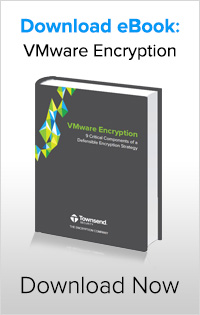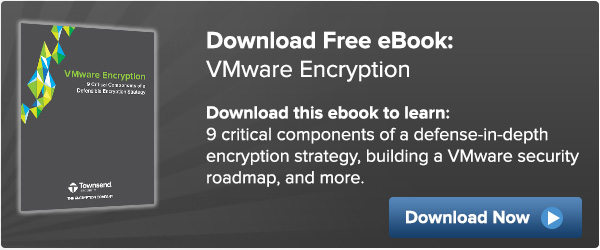 We all know encrypting sensitive data such as customer, employee, and business critical data is not only crucial to protecting your company’s assets, encryption is also required by industry regulations such as the Payment Card Industry Security Standards Council (PCI SSC) and GLBA/FFIEC. Today businesses are turning to VMware virtual machines and the cloud to reduce cost and complexity within their IT environments. When companies set out to encrypt sensitive data that is stored or processed in VMware, meeting industry regulations is top of mind. Businesses also sometimes assume that meeting the encryption requirements of a regulation will protect them from a data breach as well. Unfortunately, passing a data security audit does not always guarantee a strong defense to a data breach. Where data is encrypted and how it is encrypted is often subjective to the auditor, and where one auditor might give your encryption solution a passing grade, another might fail you. If you are only looking for a passing grade, you may be implementing the bare minimum requirements. When you consider the possible deviation between one auditor to the next, it becomes clear that meeting compliance is often a low bar.
We all know encrypting sensitive data such as customer, employee, and business critical data is not only crucial to protecting your company’s assets, encryption is also required by industry regulations such as the Payment Card Industry Security Standards Council (PCI SSC) and GLBA/FFIEC. Today businesses are turning to VMware virtual machines and the cloud to reduce cost and complexity within their IT environments. When companies set out to encrypt sensitive data that is stored or processed in VMware, meeting industry regulations is top of mind. Businesses also sometimes assume that meeting the encryption requirements of a regulation will protect them from a data breach as well. Unfortunately, passing a data security audit does not always guarantee a strong defense to a data breach. Where data is encrypted and how it is encrypted is often subjective to the auditor, and where one auditor might give your encryption solution a passing grade, another might fail you. If you are only looking for a passing grade, you may be implementing the bare minimum requirements. When you consider the possible deviation between one auditor to the next, it becomes clear that meeting compliance is often a low bar.
At Townsend Security we help our customers not only meet compliance, but achieve a level of security in their VMware environment that will protect them in the event of a data breach. Our new eBook, “VMware Encryption: 9 Critical Components of a Defensible Encryption Strategy,” discusses nine strategies for ensuring your VMware encryption strategy is strong enough to protect your business in the event of a data breach.
Download this eBook to learn more about these critical components and more:
1. Establish a VMware Security Roadmap
The first step in securing your VMware environment is to establish a security roadmap. Determine how encryption and key management in VMware fit into a holistic security plan, and assess security requirements that compliance regulations mandate. Assess your level of risk tolerance for the types of data you want to protect. It’s important to keep in mind that compliance regulations may not mandate the protection of some data, such as email addresses and passwords; however, you may want to encrypt this data in order to protect your brand and reputation should this data get breached. At an IT level, like other security applications that perform intrusion detection/prevention, and active monitoring, you should deploy your encryption key management virtual machine in a separate security workgroup and provide administrative controls in the same way as for other VMware and third party security applications. [Download the eBook to read more]
2. Inventory and Prioritize Sensitive Data
Every encryption project should start by making an inventory of sensitive data in your IT environment. The first step is to define “sensitive data.” Sensitive data is any customer or internal data that you must protect in order to meet compliance requirements or protect your customers, employees, and yourself from data theft and fraud. The scope of what is considered “sensitive data” and how hackers use data to commit fraud is growing. However, if you do not know where to start, first consider the compliance regulations you fall under. [Download the eBook to read more]
3. Use Industry Standard AES Encryption
Encryption protects your data at the source and is the only way to definitively prevent unwanted access to sensitive data. Academic and professional cryptographers have given us a number of encryption algorithms that you can use to protect sensitive data. Some have interesting names like Twofish, Blowfish, Serpent, Homomorphic, and GOST; however, it is critical in any professional business to use encryption algorithms accepted as international standards. Many compliance regulations require the use of standard encryption, such as AES, a globally recognized encryption standard, for encrypting data at rest. [Download the eBook to read more]
4. Encryption Key Management
Many organizations that encrypt sensitive data fail to implement an adequate encryption key management solution. While encryption is critical to protecting data, it is only half of the solution. Your key management will determine how effective your encryption strategy ultimately is. When encrypting information in your applications and databases, it is crucial to protect encryption keys from loss. Storing encryption keys with the data they protect, or using non-standard methods of key storage, will not protect you in the event of a data breach. For businesses that are already encrypting data, the most common cause of an audit failure is improper storage and protection of the encryption keys. [Download the eBook to read more]
Download “VMware Encryption: 9 Critical Components of a Defensible Encryption Strategy,” to learn 5 more critical components! Learn how to protect your customers, secure your business assets, avoid regulatory fines, and protect your brand.

